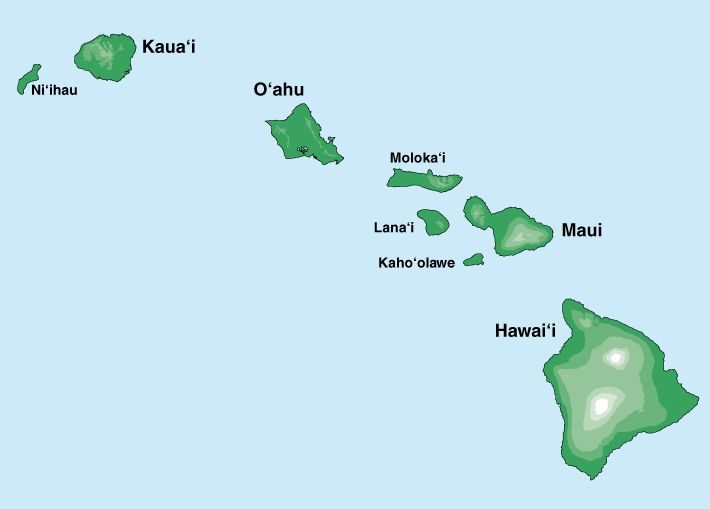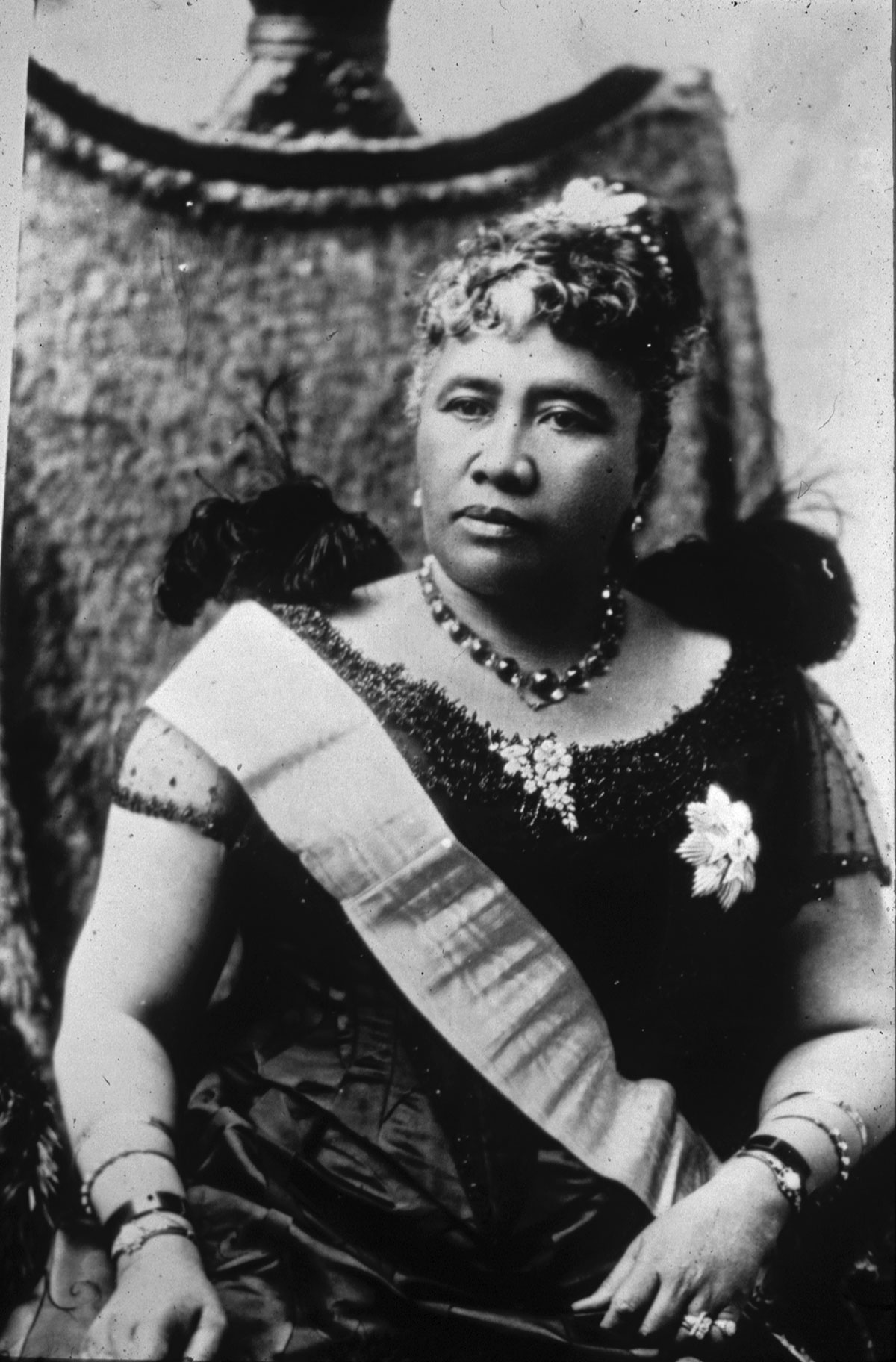Language In Hawai'i
Native Hawaiians on the Big Island
Monica Williamson

Introduction
The oldest language program in the country was formed by the Hawaiians. They have been a model to Native American groups through their success. Today, high school graduates are required to take a Hawaiian history and culture course prior to graduation. The University of Hawai’i Hilo was the first Language College as well as the home of the first available graduate degree for an Indigenous language in the nation (Benham, Cooper, pg. 76). From pre-k to higher education, learning Hawaiian is an option for those who pursue it. But, this has not always been the case.
The Kingdom of Hawai'i Practices Peace
In 1778 the first white foreigners came to the Hawaiian Islands. The incoming visitors were mostly missionaries spreading Christianity and in the first forty years of their time on the islands, they managed to do just that (Benham, Cooper, p. 74). Life on the islands gradually began to take new form as westernization expanded rapidly, and along with the new faith came the English language. By the mid 1800s, the Hawaiian language became one mostly spoken in the privacy of residency as English was used for more formal conversation. In 1893, the monarchy of the Kingdom of Hawai’i was illegally taken over.
After a forced constitution surrendering their power, the Kingdom, once well lead by a linage of peaceful protectors of the land, met United States troops along their coastal border. As countries on its west brought in workers for sugar plantations that populated its islands and economy, the country to its left sent its armed men to dominate it (Benham, Cooper, p. 74).
Their Queen, by voicing the Native Hawaiians’ vote for a constitution that would put power back on the monarchy’s throne, was accused by Americans to have made an, “act of revolution”. A European and American provisional government group claimed that American citizen protection was immediately needed on the Islands. Sending troops to challenge the Queen, they made political provisions that led to the American flag waving above the government building of the Kingdom of Hawai’i within no more than four days.

Queen Liliuokalani was the last queen of the Hawaiian Kingdom. After being taken in the dark of night from her own palace in Honolulu, Hawaii when white missionaries overthrew her, she wrote in a letter, “…I must forgive and forget the past… trusting that all will hereafter work together for peace and friendship for the good and for the glory of our once happy land,” (Liliuokalani, p. 308). The Queen upheld the deep rooted necessity for unity and peace on the islands. Through aloha, she stepped down from her throne simply to avoid the bloodshed of her people- a noble act of peace that was motivated by the deep love she had for the Kingdom and those she served.
The annexation of Hawaii took place in 1898, and the results were and still are devastating. Hawaiians lost the right to vote, practice their spiritual hula dance, and learn their Native language: a fraction of grievances that resulted from this settler colonialist takeover. The annexation took away Hawaii’s political self-determination, and western ideals began to conquer. It made teaching Hawaiian language in schools illegal, an overt example of discrimination (Merry, 35).
The cultural devastation that was the annexation of Hawaii nearly eliminated the Hawaiian language. Today, The Native’s now make up just 21% of Hawaii’s population, and among them few fluently write or speak the language. Hawaiians have remained on the forefront of continuing their cultural education. Charter schools have sprung up on the islands and they utilize their private system to teach aspects of Hawaiian culture. One main focus is the teaching of their language to strengthen all other parts of their spiritual existence. I will further explore ideals of the Hawaiian culture that have dictated the approach to this new wave of education.
A Commitment to Preservation
ALOHA: In the commercialize, western world the word aloha is most closely associated with tropical-print t-shirts, surf boards, and the hang-loose hand gesture. The term can be used in a way that makes it as tacky as dashboard hula girls while representing no importance to everyday life. By those uneducated on the richness of the term, it is often undervalued.
Aloha means both hello and goodbye. What aloha really is, though, is word that is used to show love and affection: the root of Hawaiian culture. Aloha, or the Aloha Spirit, is a concept that drives the everyday actions of locals on the islands, especially native Hawaiians who make up roughly 21% of Hawaii’s population (Office of Hawaiian Affairs).
Broken down, “alo” means presence or to be present face to face, and “ha” means breath of life (McGuire, 2015). Together, the word aloha can be translated to “presence is the breath of life.” To live a life of aloha, one must be motivated to live a harmonious way of life that coexists with others and with the land in a respectful way. Activist and Hawaiian cultural expert Pueo McGuire explains aloha as, “…walking with loving intentions and speaking the truth.” To live this life, one must come to terms with their intentions, and must also know what the truth is. Not only think, but walk.
A breath exchange, called honi, can be physically represented through a literal exchange of breath when one person places their nose on another person’s nose as they inhale simultaneously through their noses (McGuire, 2015). This differs greatly from the mainland’s typical greeting of no more than a handshake.

AINA: According to Hawaiian mythology, in the beginning coral was born in the darkness of the sea. Worms grew on the coral and began digging into the ground. Soon, more complex lifeforms, like starfish and sea cucumbers, emerged from the sea and created tribes with their varieties. Soon, a duality began. What was born in the sea was also born on land, the volcanic mountains (McGuire, 2015). A veil sits at the surface layer of the ocean separating two environments that must coexist in fragile balance; what lives under the sea cannot come above the surface without dying, and what lives above it cannot submerge below the surface without the same result as well (McGuire, 2015). This precious balance of creation is what influences the people of Hawaii to care for their land with respect. Without one, we cannot have the other. Preserving all cycles of life is essential because we, as humans, cannot provide life- only the earth can. (McGuire, 2015). “Nature is family. Always think: family,” says McGuire. Hawaiians believe there is no separation between humans and nature, we are nature; when we think there is a separation, we also think the land is indispensable and ours to modify (Wheeler, 2005).
Through rituals and stories, Hawaiians have continued to actively live the ways of their ancestors who have protected the land and used it sparingly. McGuire (2015) says, “I am only who I am because of my environment. We are shaped by it, we do not shape it.” This love of the land has a term in the Hawaiian language, and it is aloha aina. Although a direct translation doesn’t exist, aina most closely can be translated to land. Aina coupled with the word aloha is an extension of aloha’s meaning, as it ties people to their land through the creation story of their people.
Hawaiians always look to the past to know about the present and consider their ancestors to be a part of their everyday routines. “We are borrowing our world from the future,” McGuire (2015) says. By knowing where they came from, the successes and challenges of the past, and the values that were learned from each experience, Hawaiians carry on a rich tradition through teaching their practices.
Spreading Success
Aina and aloha embellish the existence on the islands and always have (Benham, Cooper, p.71). Their pace of life is incorporated around cooperation rather than competition, and they view themselves to be inseparable from nature. For this reason, sustaining themselves is also sustaining the environment. The success of sustaining their programs stems from their holistic approach to teaching. In a collective way, it is essential to embrace not only the mind but the body and spirit (Benham, Cooper 71). The goal of Hawaiian language immersion programs is to educate their students on indigenous philosophy by establishing the Hawaiian ways of life (i.e. aina and aloha)(Wheeler, 2005). They have set the standard for the opportunity to teach and care, and dp not mistaken the peacefulness of aloha to be a weakness (McGuire, 2015). They aim to not just let the language to survive, but to allow it an environment to flourish (Benham, Cooper, 73).
Citations
Allen, Helen G. 1982. The Betrayal of Liliuokalani: Last Queen of Hawaii 1838-1917. Glendale, CA: Clark.
McGuire, Peuo. 2015. Native in Hawaii. Personal. Jul 1.
Merry, Sally Engle 2000. Colonizing Hawai’i: The Cultural Power of Law. Princeton, NJ: Princeton University Press.
P., Ah Nee-Benham Meanette, K., and Joanne E. Cooper. 2000. Indigeneous Educational Models for Contemporary Practice: In Our Mother’s Voice. Mahwah, NJ: L. Erlbaum Associates
Wheeler, Linda A. 2005. Aloha: The Spirit Within You. Honolulu: Po’okela Publishing. p. 10-13.